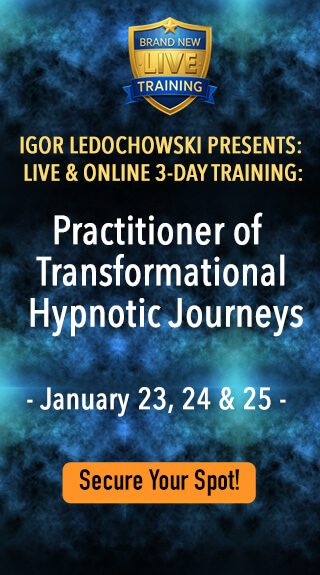
In Part 2 of our series on the art of using that all-important H+, guest writer Andres Aranda shares Milton Erickson’s unique approach to rapport, and looks at the “Nirvana approach” to H+. And if you missed Part 1 of this info-packed article, you can check it out here.
The Uncommon “Magic” Of Milton Erickson
Talking about Erickson and empathy, rapport, compassion or any other word of the kind can be baffling. For example, calling a deeply depressed young woman a “disgustingly horrible bucket of lard” and a “hideous mess” to rapidly build strong and deep rapport seems the work of a wacko. And yet it worked, jaw-droppingly worked.
But before you engage in verbal abuse with the next person you stumble upon and wait for the magic to happen, you must understand why Erickson would have such seemingly disrespectful and abusive kind of interactions – otherwise all you’ll get will be a punch in the face!
When a person is deeply entailed in a dysfunctional mental and behavioral pattern, any information that doesn’t match this pattern will be rejected bold-facedly.
The girl I just talked about was grossly obese and had lost the only two persons she felt could possibly value her (her father and sister). In her mind, everyone else saw her as terribly disgusting as she saw herself. Erickson explains that he had to use unkindness and brutality “to convince her of my sincerity. She would have misinterpreted any kindness and could not possibly believe courteous language.”
 This kind of intervention requires extremely high skills and I personally wouldn’t dare to use it with “so little” information. Of course, what most can see about this case is nothing compared to what Erickson should have been able to unconsciously grasp given his unmatched abilities.
This kind of intervention requires extremely high skills and I personally wouldn’t dare to use it with “so little” information. Of course, what most can see about this case is nothing compared to what Erickson should have been able to unconsciously grasp given his unmatched abilities.
This situation may seem quite distant from anyone not involved in treating deeply disturbed people, but similar situations take place in more day to day situations: A business prospect going through a no-cycle over and over again, teenagers sabotaging their parents directions by doing it all wrong, children unable to get out of a tantrum even when they get away with what they want, just to name a few.
If Rogers’ is a Client-Centered Therapy, Erickson’s has to be defined as a Client-Tailored Therapy. Each situation is addressed in a unique way, taking account of personal trends, values and circumstances. This is viewed as a whole and should be addressed as such. There’s no separation, no way of conceiving the person as being independent of its environment, of its “symptoms.”
Thus it becomes clear that verbal abuse is not a technique or style to do therapy work, it’s just a resource that was used in that unique situation because it made perfect sense.
And like this, there are plenty of reported cases in Erickson’s writings in which therapy falls out of any conceivable classification: Curing insomnia by prescribing not to sleep, helping a couple to conceive by shocking them using the F word, getting a patient through her insecurities by “failing” as a hypnotist, removing stage fright from a pianist by meticulously planning his next faint, and the list goes on and on.
There have been plenty of attempts to systematize the work of Milton Erickson in some way or another, and there have been important outcomes from these efforts: Ericksonian therapy, brief therapy, strategic family therapy, family systems therapy, solution focused brief therapy, and neuro-linguistic programming.
Yet, there’s no real “system,” not a true way to reproduce what Erickson did in practice. And that’s because he was unique in a way that is really hard to grasp: he was a different therapist for each patient, just the right therapist to meet their needs and do the work. The harsh-talking tyrant could also be sweet and tender, or full of jokes and fun. He was the disrupting element of the patient-problem system; he always got to be part of the system.
So, how can these incredible abilities be developed? How someone can understand so clearly what needs to be done? And the answer is “unconsciously” of course. Erickson viewed the unconscious mind as creative and generative. He used to say:
“I go into trances so that I will be more sensitive to the intonations and inflections of my patients’ speech. And to enable me to hear better, see better.”
Is there a method for that? Well, yes and no. First things first: No, you can’t become Milton Erickson, nor do I or anyone else in the world. But, can you take H+ to a level in which you can fully understand your clients and propose wildly creative and effective solutions to them, even when you’ve got to a “dead-end”? Hell yes!
The question again is HOW? And the answer lays hidden in ancient wisdom…
The “Nirvana” Approach
The Nirvana approach refers to the Buddhist concept of illumination, more specifically refers to the concept of mindfulness. It is a concept in psychology derived from the Buddhist meditation Anapanasati and popularized in the west by Dr. Jon Kabat-Zinn.
This meditation is one of the paths Buddha taught in order to reach Nirvana. The western conceptualization of this practice lays in three basic principles:
- Don’t reject those things you preconceive as negative
- Don’t hold onto those conceptions you believe to be true or necessary
- Don’t look for a solution, for a way to get things “right” (as you would be holding to preconceptions again)
Just perceive the world with bare attention, nothing else.
These three principles are great to go into a non-judgmental state, yet this conceptualization lacks the original intention of the exercise (which is actually crucial): to see the world as it is, which means to learn to see the world, to really understand. The western version is very alike Rogers’s method, whilst the eastern one is deeper, closer to what Erickson used to do.
If client-centered therapy is all about walking in someone else’s shoes for a while, Erickson’s method would be more about living under the client’s skin for a while. It’s not just about watching the world from the client’s point-of-view, but experiencing the world the way your client does, becoming a two-people version of your client so that every conversation is in fact introspection and every suggestion is an autosuggestion.
Reflective listening tends to be quite rational, while Erickson’s uncommon therapy (when it had to be so) tends to seem senseless, unreasonable and even random.
Of course it looks this way when you’re outside the system, when you make a distinction between yourself, your client and her behavior. But when you become a part of it, when you experience the world in the same way, you have a deeper understanding of what’s really going on.
So, what does it take to get to this deeper understanding, how can you erase the boundaries between you, your client and the problem while bringing in some resources to break the vicious cycle at the same time? Follow the same steps Roger laid out, but with a few additional tweaks…
1. Begin by going first to a clean state of openness (this can be achieved by combining the instant rapport technique with the heightened awareness meditation).
2. As with the Rogers’ method, find the real goal your client is pursuing, but this time focus more on eliciting the values that motivate that goal. To know you’re there, that you can “really feel” the actual goal, you need to be able to feel a sense of urgency to reach the goal within those values.
3. Then you start to look for blocks, but this time you don’t just focus on identifying the blocks, but also on the feelings associated to those blocks as well. In a therapist/patient scenario a “how do you feel about that?” questioning can seem adequate, but in a business situation it may easily feel odd, so adjust your strategy as necessary. The goal is to get the full movie out of them, not just the Twitter news report on the subject.
4. Again, Mind Bending Language can be used to start reframing whatever needs to be reframed; yet it is quite possible that you find objections even to really indirect suggestions. Take this step as a way to gauge the depth of your connection with the client. If you can’t feel the blocks, if you can’t experience the client’s problem as a problem to yourself, then you’re not quite there.
5. Every time your suggestions are rejected take that as an indication to dig deeper and ask questions to better sense the situation (because to get an understanding, you need to sense it before you actually can conceptualize it).
6. Once you can really sense the problem, then you can choose your intervention. This intervention will make sense, but not in a pure rational way (although it may sound really logical while you’re pondering it). It will make sense in your gut, it will feel right.
7. Once you’re done with your intervention you may future pace a new state to face the problem in a way it’s no longer problematic.
All these methods require practice and a true willingness to learn from errors and adjust to each situation, but once you really fine-tune your H+ abilities, results will speak for themselves. And believe me, they will handsomely speak…
What do you think of the “Nirvana” approach to extreme H+, or of Erickson’s famous and unconventional techniques? Would be great to get a conversation rolling on this one, so please share your views in the comments section below!
And if you’re a hypnotist or hypnotherapist, or would like to share an inspiring story about hypnosis, why not write for our global community (just like Andres did). To find out how you can become a published writer, click here.









![[ADVANCED GUIDE] How To Master Hypnotic Regression Therapy - Part I: Essential Principles To Profoundly Transform Your Subject’s Emotional Trauma [ADVANCED GUIDE] How To Master Hypnotic Regression Therapy - Part I: Essential Principles To Profoundly Transform Your Subject’s Emotional Trauma](https://hypnosistrainingacademy.com/wp-content/uploads/2016/09/hypnotic-regression-therapy-essential-principles.jpg)


![Yogic Breathing For Hypnosis: 3 Easy Techniques To Ground & Relax Your Clients Before Inducing A Hypnotic Trance [Includes Infographic] Yogic Breathing For Hypnosis: 3 Easy Techniques To Ground & Relax Your Clients Before Inducing A Hypnotic Trance [Includes Infographic]](https://hypnosistrainingacademy.com/wp-content/uploads/2019/05/yogic-breathing-for-hypnosis.jpg)
